Strawberry IPM Newsletter No. 2- May 29,2020
Strawberry IPM Newsletter No. 2- May 29, 2020
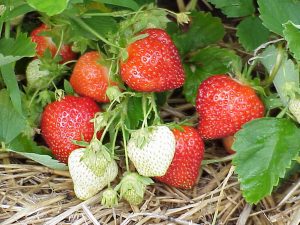
Click on photos to enlarge
SLOW GROWTH IN THE STRAWBERRY FIELDS
Spider Mites Active Despite Early, Cool and Wet Conditions
Twilight Meeting: Tuesday June 16, 2020 at 6:30pm at Blackie’s Farm Fresh Produce in Auburn, Me
Situation:
This spring has been characterized by cool, cloudy and wet conditions, resulting in slow strawberry growth with many fields seven to fourteen days behind “normal” development. Primary blossoms are opening up in southern Maine on matted-row plantings, but just a few flowers are showing along the edges of the fields with early varieties further north. Plants on plastic mulch that had rowcovers this spring are at full bloom or slightly beyond. In either case, protecting buds and flowers from frost injury has been a major concern for the past two weeks. Frost injury (black centers in the flowers) has been present in every field I’ve visited with blossoms or buds showing, but so far levels have been low to moderate, as growers have been doing their best to protect buds with irrigation or rowcovers. Winter damage is evident in some fields, especially in older beds, or areas where mulch was not thick enough for good protection.
Twilight Meeting Tuesday June 16th at Blackie’s Farm Fresh Produce, 966 Minot Ave., Auburn. Blackie’s Farm Fresh Produce is a year-round fruit and vegetable stand that sells retail and wholesale. This meeting will focus on marketing and setting up displays. The meeting will begin at 6:30 which is a little later than usual due to the activities at the farm stand. We will also will get an update on the vegetable and berry pest situation around the state, and have an opportunity to look over the stand, storage and displays. We anticipate that one pesticide applicator re-certification credit will be awarded for the meeting. See you there!
Strawberry bud weevil or “clipper”:
With bloom about to get underway, this is the time that clipper damage starts appearing. Activity has been very low in fields that I’ve scouted this week, with only a few indications of feeding injury in couple of the fields, and no clipped buds yet. The control threshold for clipper injury is more than 1.2 clipped buds per two feet of row. Small holes in the petals of opening flowers indicates clipper feeding activity, and is often first noticed in the border rows. Expect clipper damage to increase as temperatures warm and later blooming varieties begin to flower. Insecticide options for clipper include Lorsban®, Brigade®, Bifenture®, Danitol®, Sevin® and PyGanic®. Clippers will also attack the buds of raspberries and blackberries, although they do not usually cause significant injury.
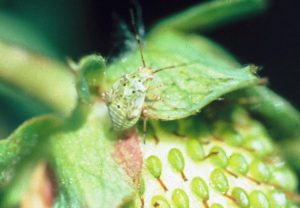
Tarnished plant bug activity has also been very low this week, likely slowed by the cool, wet weather. So far, I have only seen a couple of adult bugs in the fields, and no nymphs. The nymphs can be hard to find, especially if the plants are wet. Young nymphs are very small (2 mm), active, yellow-green insects. It is important to scout for them regularly, as they may appear very quickly as the weather improves. The threshold for plant bug nymphs is 4 or more flower clusters infested per 30 sampled. You don’t have to count the nymphs; just tap flower clusters over a plate or tray to knock any nymphs off. If any appear on the plate after tapping, count that cluster as “infested”. Start scouting any field with open flowers now. Insecticide options for tarnished plant bug include malathion, Assail®, Brigade®, Bifenture®, Dibrom®, Danitol®, and PyGanic®.
Two-spotted spider mites:
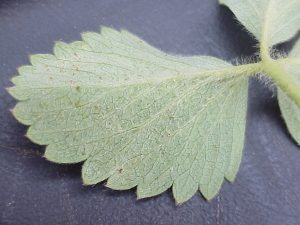
Cool, wet weather is generally not conducive to spider mite infestations, but I have been finding mites and eggs in nearly every field I have scouted this spring, with some well over the spray threshold of 25% or more of leaves sampled having mites. As temperatures become warmer we may see more problems with mites. It is important to scout for them regularly. If 25% of leaves sampled (e.g. 15 out of 60) have any mites, a spray should be applied. Chemical control options for two-spotted spider mites include Acramite®, Savey®, Zeal®, Portal®, Vendex®, Oberon®, Brigade®, and Danitol®.
Cyclamen mites:
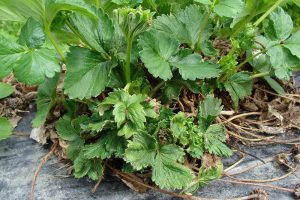
I have seen some indications of cyclamen mite injury in fields this week, but it is has not been wide spread and I have not yet found active mites on any plants. Infested plants show weak growth and shrunken, crinkled leaves. These mites are very small and reside in the crown of the strawberry plant, feeding on the developing leaves and flower buds. They are very hard to see, even with magnification. Portal® can be effective, but must be applied in lots of water to be sure that the material is carried down into the crowns where these mites reside.
Diseases:
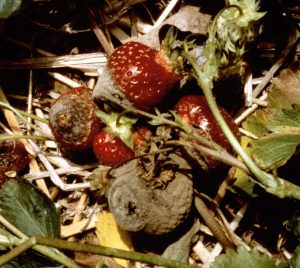
As the fields come into bloom it is important to protect the flowers against infection by spores of the gray mold fungus, Botrytis cinerea. Most fruit infections take place through the flowers, so control efforts should be focused on the bloom period. Two to three sprays of fungicide are typically required to provide good protection. The first spray is usually applied at 5-10% bloom, followed by a second application at petal fall. Additional applications may be applied if there is significant rainfall between or following these two sprays. Once spray materials have dried on the plants, they are generally considered “rainfast”, unless there is more than one inch of rainfall. Once more than one inch of rain has fallen, or there has been significant shoot or flower growth that is unprotected since the last application, another fungicide application should be applied to assure adequate protection. Remember to alternate fungicide and insecticide chemical families to prevent the development of pest resistance.
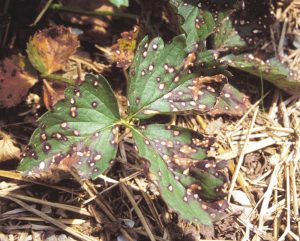
Leaf spot is a fungal disease characterized by small purple spots with white centers on the leaves. The symptoms are often first visible on the older, lower leaves. I’ve seen some leaf spot in fields scouted this spring. If you see leaf spot in your field, you should consider using a fungicide that will provide control as part of your spray program for gray mold. Products such as Captan®, Luna Sensation®, Mervion® and Pristine® have activity on both diseases.
Leather rot (Phytopthora cactorum) can become a problem in fields where standing water is common during bloom and fruit development, especially if the fields were not mulched last fall. Incidence of leather rot can be reduced by applying straw mulch between the rows to prevent berries from touching the soil and reducing soil splashing onto the berries. Foliar sprays of Aliette®, Prophyt® or Phostrol® may be applied during bloom and fruit development to prevent leather rot.
Other Berries:
Highbush blueberries are showing varying degrees of winter injury around the state, ranging from none to moderate. Mummy berry shoot strikes may become evident on bushes soon. The recent weather has been very favorable for mummy berry development, so growers should be applying appropriate fungicides to protect against this disease. Registered materials include Orbit®, Indar®, and Quilt Xcel®. See the New England Small Fruit Management Guide for details.
Raspberry canes are showing very little winter injury, but some injury may become evident in the coming weeks as fruiting laterals on the canes start to elongate and flower, only to suddenly wilt and die. This delayed injury is due to the inability of the damaged vascular system to support this additional growth, especially in hot, dry weather.
The most up-to-date version of the New England Small Fruit Management Guide is available online.
Remember, for pest management questions you can access this guide online at: New England Small Fruit Management Guide.
Sincerely,
David T. Handley
Vegetable and Small Fruit Specialist
Highmoor Farm UMaine Extension Diagnostic
P.O. Box 179 Research Lab, Pest Mgmt. Unit
52 U.S. Route 202 17 Godfrey Drive
Monmouth, ME 04259 Orono, ME 04473
207.933.2100 1.800.287.0279
The University of Maine is an equal opportunity/ affirmative action institution.
Where brand names or company names are used, it is for the reader’s information. No endorsement is implied nor is any discrimination intended against other products with similar ingredients. Always consult product labels for rates, application instructions and safety precautions. Users of these products assume all associated risks.
